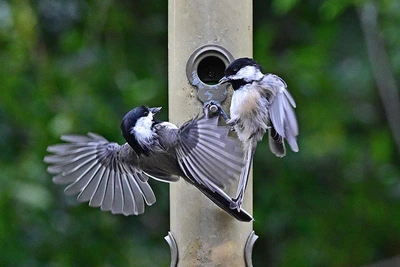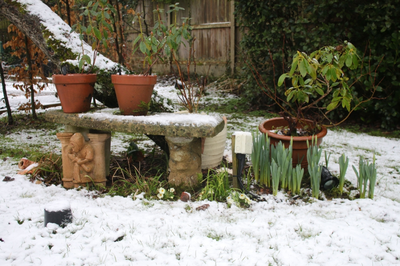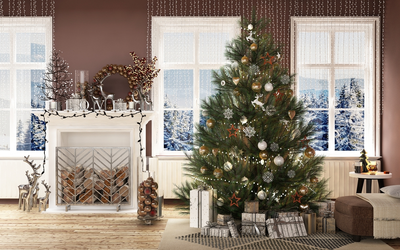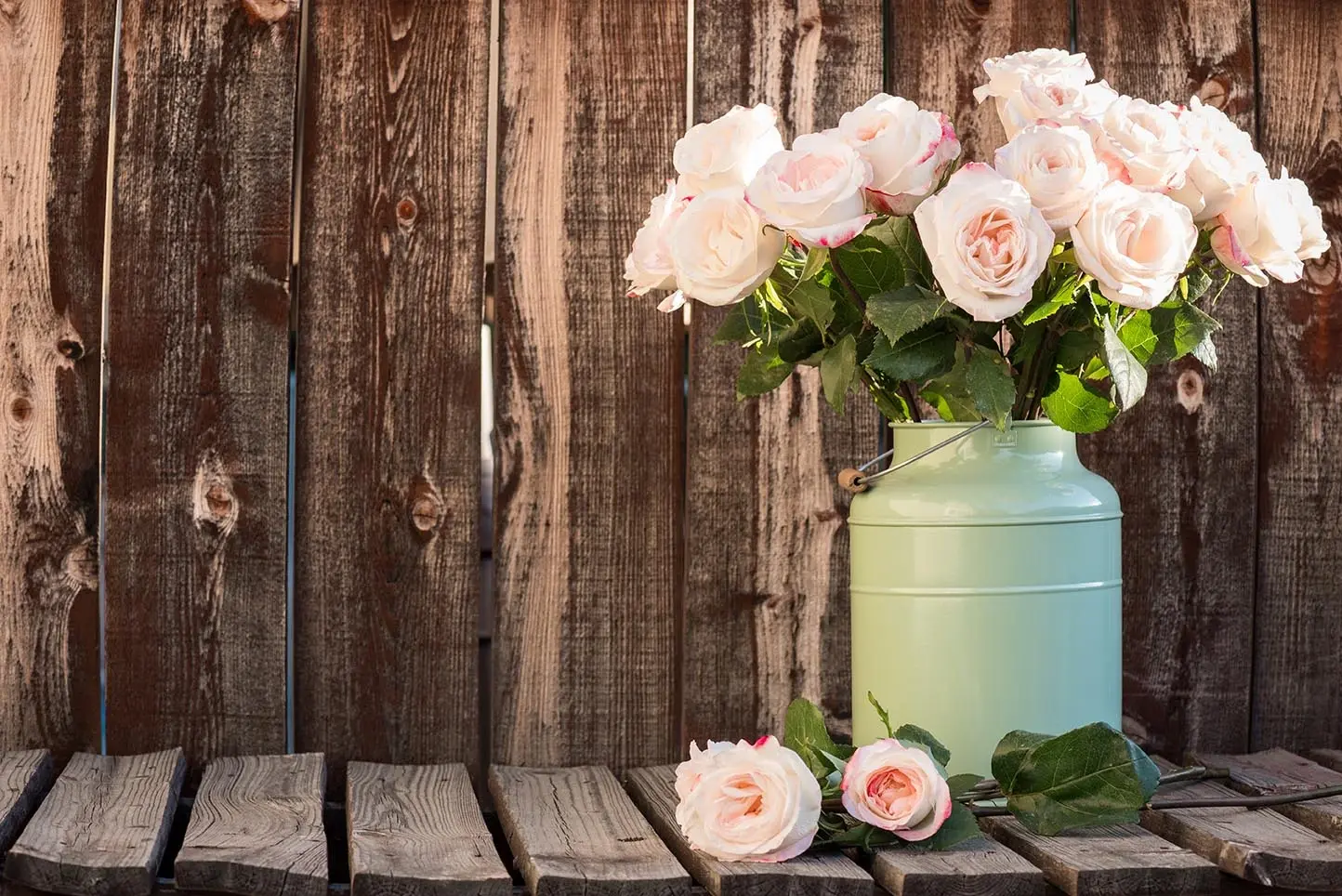
How to Grow and Care for Roses
Beautiful fragrant roses can easily be grown in your garden or container. All it takes is lots of sun, a little fertilizer, consistent watering and basic gardening skills.
The more care and information you know about roses, the more successful you will become at growing them. A properly maintained and cared for rose garden will produce beautiful, fragrant blooms from June until frost.
Buckerfield’s Garden Centers have everything you need to help you grow beautiful roses. Our qualified staff can assist you with the right insecticides, fungicides, pruners, soils, mulch and the prettiest roses. There's a perfect rose for every space in your garden!
Growing beautiful roses requires neither great rose gardening skills nor experience. The following information describes how to get your new rose plant off to a great start.
- Choose a sunny location.
- Plant in early spring when all danger of frost is past.
- Choose a sunny area of the garden that gets at least 4 to 5 hours of sun.
- Do not crowd your rose with other trees and plants. Give them plenty of room.
- If you’re replacing an older rose bush, remove an 18 cubic inch area of soil and replace it with fresh soil.
Planting Roses
Choose to plant fragrant roses, next to a bench, lawn furniture, gazebos, pergolas and garden ponds. Roses look and smell great!
- Water the rose thoroughly before planting.
- Dig a hole approximately 15 inches deep and 18 inches wide.
- Add a small handful of bone meal to the planting hole. Mix in compost or peat moss to loosen the soil. Mix the soil you took out of the hole with more compost or peat moss.
- Remove the rose from the pot. Carefully place in the hole and shovel the extra soil around the new plant. Plant the rose with the crown slightly deeper than the original soil. The crown or bud union should be about 1 inch under the soil
- Gently press the rose into the soil and water well. Watch it grow!
Mulch Generously
Spread organic mulch, such as wood chips, pine needles, grass clippings or other biodegradable material around each rose. Mulch helps minimize weeds, keeps the soil moist and loose, and adds essential nutrients.
- Apply in the spring just as the soil warms and before weeds start to grow.
- Spread 2 to 4 inches around each plant.
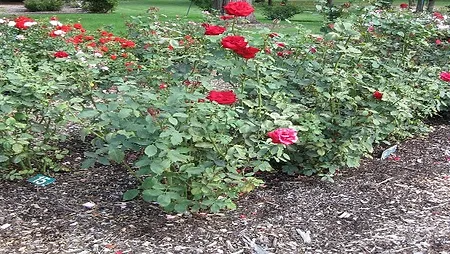
Pruning Roses
Keeping your roses pruned properly every year will ensure healthy plants, and big, beautiful, fragrant flowers.
- To prune roses you'll need the following supplies: sharp pruning shears, long handled lopping shears, and gardening gloves to protect you from thorns.
- Well established roses should be pruned while the plant is in its dormant stage.
- When pruning roses, your goal is to have an opened centered bush when you are done and your plant should have a vase Shape.
Here are some pruning tips:
- Start by cutting out all dead wood and all canes that are diseased or damaged. Open the bush up by removing all branches that cross through the center. Cut out very thin canes, and remove any branches that cross or rub together. Keep the nice green healthy canes. This allows for better air circulation.
- Cut the stems back by a third to a half, depending on how tall you want the bush to be.
- Keep the center of the bush free of canes that are growing horizontally. This promotes good air circulation which helps prevent fungal infection. As the center starts to open up, remove any leaves or debris to keep insects and diseases at a minimum.
- When removing an entire cane, make the cut as flush as you can to the bud union. If you leave a stub, it can die back into the bud union allowing entry for disease and pests.
- Make all cuts above a leaf bud that points towards the outside of the plant. Make all cuts clean. Try not to make any ragged cuts, as this will allow insects and disease into the plant and open it up to infection. Always prune to a healthy bud. Make sure your cut is at a 45 degree angle going away from the bud.
- Always cut just above the bud. You don’t want to cut it too close or too far away. If you cut it too close, the bud is damaged, if you cut too far away, you can have die back and possible disease.
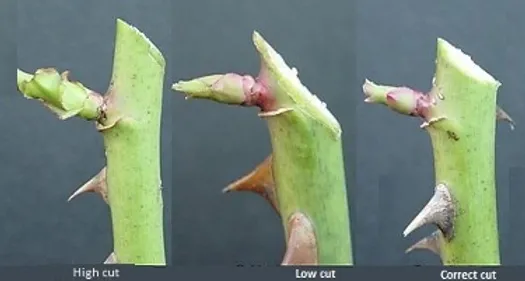
- Cut surface should be white and healthy.
- Remove Any Suckers. These are long, slender, flexible canes that originate from below the bud union.
- Paint cuts with a sealing compound to prevent disease and pests.
Climbing roses only need to be pruned when it is growing in the wrong direction or when you are trying to contain its overall size and height.
Fertilizing Roses
Begin fertilizing roses regularly at the start of the growing season in early spring.
For big blooms all season use 8-14-12 Rose fertilizer applied according to manufacturer instructions. Available at Buckerfield’s Garden Centers.
- The first feeding of your roses should be done when the bush first starts to leafs out.
- For the remainder of the growing season, fertilize after each flush of blooms.
- Scratch dry fertilizers into the soil beneath the leaves and water well.
- Stop fertilizing roses at least one month before your first annual frost date. Fertilizing too long into autumn encourages roses to produce tender new growth that will get nipped by cold.
Watering Roses
Water diligently. Roses need a steady source of water during the growing season, about 1 inch a week from rain or watering.
Roses should be watered deeply, but infrequently to encourage strong root growth. The actual frequency of watering will depend on your soil and climate. Roses love water!
Here are a few tips to ensure they get enough water.
- Water in the morning and avoid wetting the plant's leaves, to help prevent black spot and mildew.
- Shower your roses with a spray nozzle once a week. This will clean the leaves of dust, dirt, spider mites or other harmful insects.
- Water two to four times a week for about 30 minutes, especially in very hot or windy conditions. Roses should receive 1 to 2 inches of water each week.
- Container roses will need to be watered frequently because water evaporates more quickly from plants above ground.
- Mulch 2 to 3 inches around each rose to help retain moisture, keep the soil cool and help control weeds.
How to Deadhead Roses
Deadheading remove spent blooms, improves the overall look of the plant and encourages greater flower production. Flowers that have begun to wilt or are dropping petals need to be removed. This will ensure plenty of new growth and beautiful buds.
- Locate the first set of 5 leaves beneath the bloom.
- Cut the branch at a 45 degree angle slightly above the first group of 5 leaves you located beneath the bloom. Use sharp bypass hand pruners to make the cut.
Controlling disease and insects
If your rose bush becomes diseased or has an insect infestation, you may need to apply an insecticide or a fungicide. Early detection and regular treatment are recommended as insects and fungus spread quickly.
Insects:
Aphids and most other sucking insects are easily treated. There are a variety of insecticides that will effectively eliminate this problem. Organic gardeners use insecticidal soaps.
- Aphids attach themselves to the stem and the top and bottom of leaves and suck the juices from the plant, weakening it and leaving it open to disease.
- They quickly multiply if left untreated. Early and regular treatment is recommended.
Diseases:
Roses are very susceptible Black Spot, Powdery and Downy Mildews, and Rose Rust. These are all fungus infections which can be readily treated with fungicides. Apply fungicides at the first signs of disease, or in advance of hot and humid weather when diseases are most likely to occur.
Disease Prevention:
Promoting strong and healthy plants aids them in fighting diseases. Here are simple steps of disease prevention:
- Fertilize and provide ample water to promote healthy strong plants.
- Provide good air circulation by pruning your bushes regularly.
- Water early in the day. Apply water to the roots, avoiding water on the leaves if possible.
- Remove any dead and infested leaves and stems.
- Clear away grass and leaves, anything that might harbor insects and diseases.
- Treat rose bushes for insects, as they are often carriers of plant disease.
- Plant roses in sunny areas.
Winter Protection
Gardeners who live in an area where temperatures dip below freezing need to protect their roses from winter damage. Once your roses are dormant, it is time to apply the winter protection. In spring when all danger of frost is over, carefully remove the protective coverings.
For protecting roses through long cold winters:
- Remove all leaf litter from the ground and the top inch of mulch. This will help prevent anydiseases that overwinter in leaf litter.
- Give the bed a deep watering. Roses need a big drink of water before their long winter's nap.
- Cover the crown with a 1-foot-deep layer of fresh bark mulch. The mulch will protect the crown and allow air to circulate. Don’t use soil, leaves, or grass clippings as they tend to hold too much water, which can cause rot.
- Wrap the canes with burlap to protect them from wind, snow and ice.
Which Rose to grow? Choices! Choices! Choices!
Make any garden or landscape stand out with beautiful roses. Roses look and smell great! Here are some of the most popular roses.
Floribunda
Floribunda roses are a cross between a hybrid tea and a polyantha rose. These roses have the large, showy blossoms of the hybrid teas, but bloom more freely, setting clusters of three to fifteen blossoms rather than a single bloom on a stem. Individual shrubs will fit easily into any sunny border or are most striking in mass plantings.
Hybrid Tea
Hybrid teas have evolved over the last 150 years through generations of breeding.
One of the most popular roses, these teas have large flowers atop long stems perfect for cutting, showing off in a pretty vase. The flowers are one to a stem, rather than in clusters. The hybrid teas bloom starts out as a tight, attractive bud that unfurls into a breathlessly perfect flower.
Grandiflora
The hybrid tea and floribunda were crossed to create the grandiflora. Grandifloras are tall elegant plants with flowers that bloom in clusters and continuous all summer, making them perfect choices for cutting gardens. Grandifloras are big impressive roses, growing 6-8 feet tall and available in many choice colors.
Shrub or Landscape Roses
Shrub roses come in all shapes and sizes, are disease-resistance, and grow in a variety of climates, require very little pruning, and bloom consistently over a very long season. Hot summers and cold winters don’t bother these roses, which makes them ideal, low-maintenance choices for landscapes and gardens. If you are looking for easy care roses, shrub roses are the ones to pick!
Climbing Roses
Gardeners looking for vertical or horizontal appeal can transform an unattractive structure or space into a wall of bloom. Planting climbing roses on either side of an arched tunnel creates a fragrant walkway from one part of a garden to another.
Climbing roses produce long, arching canes that can be trained onto vertical supports, such as walls, pillars and arbors.
Miniature Roses
Miniature roses are the smallest of rose plants, growing anywhere from six inches to two feet tall. This rose variety is hardy, flowers continuously, is perfect for container growing and looks great planted in borders. Miniature roses fit any-where in a small-garden space. Delivering a blast of color, these hardy roses produce masses of flowers.
Tree Roses
Tree roses are made up of a hardy root stock grafted to a long stem that is, in turn, grafted to a rose bush at the top of the stem. They are very elegant lining a walkway and are a great rose for growing in large pots. Because of the graft union, extra care is needed to insure its survival over winter.
Preventing Deer Damage
Damage from deer feeding can vary depending on weather conditions and deer population. During the winter deer will eat the stems and bark of the plant. And in the summer they will eat the flower buds and foliage.
- Install electric fence or a tall 6-8 foot mesh fence.
- Repellent sprays are effective if applied regularly. But if deer are hungry enough they may eat plant with or without repellent.
- Plant your roses close to the house. The bright light and sounds of people tend to scare deer away.
- Cover roses with sturdy netting or chicken wire.
Have more questions? Visit your local Buckerfield's and we'll be happy to help!

